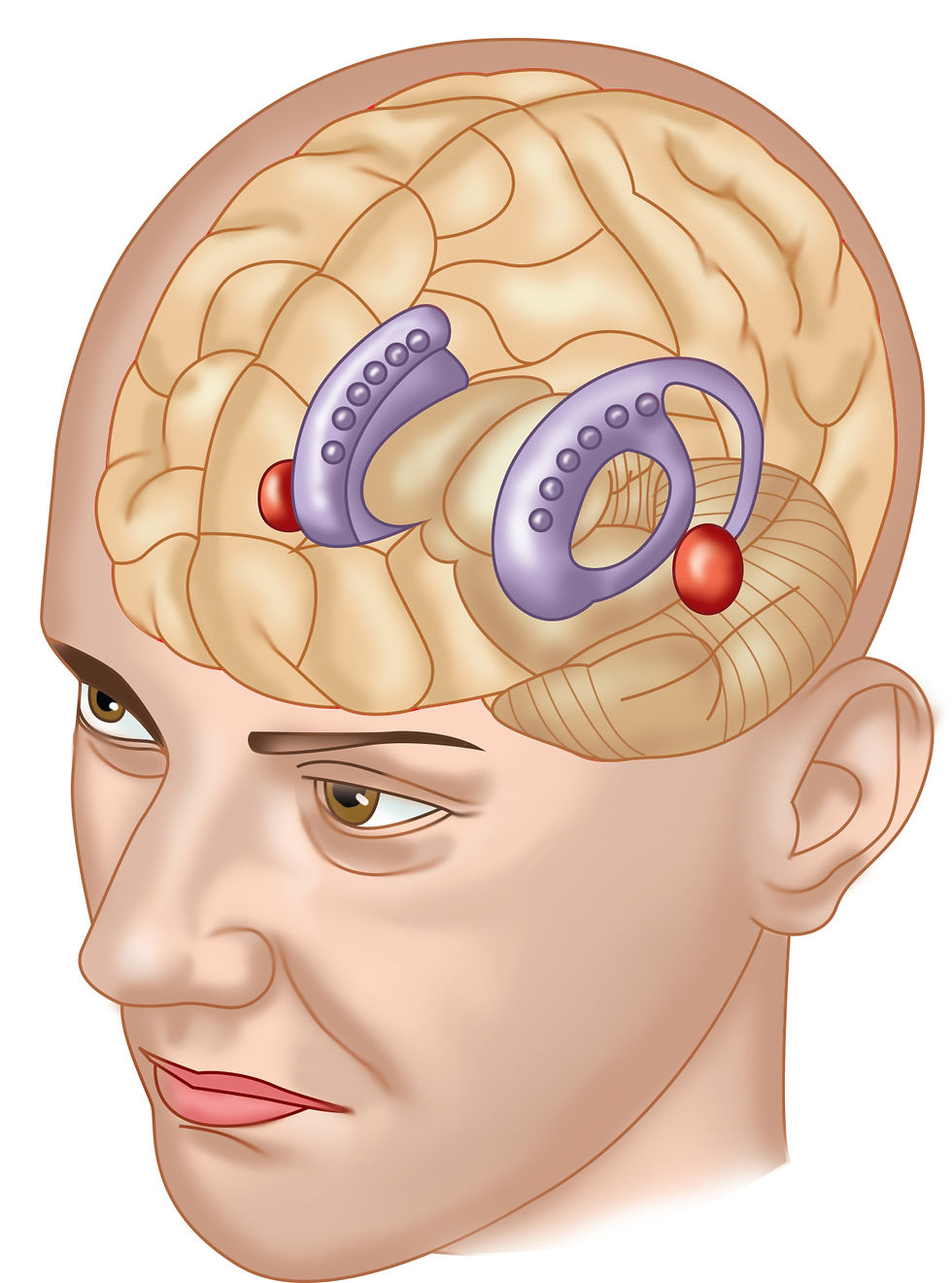A Painlessly Brief History of Serotonin
- BioSource Faculty
- Dec 5, 2024
- 8 min read
Updated: Jan 19

Serotonin, a monoamine neurotransmitter often associated with mood regulation, has played a central role in neuroscience research since its discovery in the mid-20th century.
Serotonin Overview
Known chemically as 5-hydroxytryptamine (5-HT), serotonin influences a diverse range of physiological and behavioral processes, including emotional regulation, sleep, appetite, pain, and cognitive functions such as memory and learning (Hoyer et al., 1994). Beyond its neural functions, serotonin also plays critical roles in the peripheral nervous system, especially in the gastrointestinal tract, where approximately 90% of the body’s serotonin is stored (Rapport et al., 1948).
The study of serotonin has not only deepened our understanding of neurochemical pathways but has also led to revolutionary medical advances, particularly in psychiatry and neurology. Serotonergic pathway graphic © Vasilisa Tsoy/Shutterstock.com.

Early discoveries linking serotonin to mood disorders provided the foundation for the development of selective serotonin reuptake inhibitors (SSRIs), which are now the most commonly prescribed class of antidepressants worldwide (Wong et al., 1985). In addition to its implications for mental health, serotonin research has advanced treatments for migraines, gastrointestinal conditions, and neurodegenerative diseases.
Serotonin research has evolved in response to technological advancements and shifting scientific paradigms. The initial focus on its chemical properties expanded to encompass its role in neurotransmission, receptor diversity, and clinical applications. As methodologies improved, including molecular genetics and functional neuroimaging, researchers began to uncover the intricate relationships between serotonin, brain circuits, and behavior. The modern era has also witnessed the resurgence of interest in serotonin's role in neuroplasticity and therapeutic innovation, particularly through the exploration of psychedelics acting on serotonergic pathways (Carhart-Harris & Nutt, 2017).
1930s: Serotonin Discovery in Enterochromaffin cells
The foundation for serotonin research was laid in the 1930s when Vittorio Erspamer identified an unknown substance in enterochromaffin cells that caused smooth muscle contraction. He named it "enteramine," though it would later be recognized as serotonin. This discovery marked the beginning of a new field in neuroscience and biochemistry (Erspamer & Vialli, 1937).
1940s: Serotonin Discovery in Blood Serum
Maurice Rapport, Arda Green, and Irvine Page identified and isolated a substance called 5-hydroxytryptamine (5-HT) from blood serum (Rapport et al., 1948). They named it serotonin due to its presence in serum and its ability to constrict blood vessels (Leopoldo et al., 2011). This discovery linked serotonin to vascular physiology and hinted at its broader biological significance.
1950s: Role in Neurotransmission
In the 1950s, researchers identified serotonin as a neurotransmitter in the brain. Twarog and Page (1953) demonstrated its presence in the central nervous system, leading to speculation about its role in modulating mood and cognition. During this decade, the pharmacological effects of reserpine—depleting serotonin—emphasized its link to depressive symptoms (Pletscher et al., 1955). Woolley and Shaw proposed in 1954 that serotonin might be involved in mental disorders, laying the groundwork for future psychiatric research (Azmitia, 1982).
1960s: Serotonin in Behavior and Mood
The 1960s saw growing interest in serotonin’s influence on behavior. Coppen proposed the serotonin hypothesis of depression (Jauhar, Cowen, & Browning, 2023). Carlsson et al. (1964) also hypothesized serotonin's involvement in depression, laying the foundation for the development of selective serotonin reuptake inhibitors (SSRIs). Studies also explored its relationship to sleep regulation and sensory processing (Jouvet, 1969).
1970s: Receptor Discovery and Subtypes
Technological advancements in the 1970s allowed the identification of serotonin receptor subtypes. Gaddum and Picarelli (1971) categorized serotonin receptors, marking the beginning of intensive receptor-specific research. Serotonin's role in psychiatric disorders, including anxiety and schizophrenia, was further elaborated.
1980s: Pharmaceutical Applications
The 1980s were a transformative decade for serotonin research. The development of new research methods and interdisciplinary approaches allowed for a more comprehensive study of serotonin's synthesis, storage, release, and uptake (Azmitia, 1982). Prozac (fluoxetine), the first SSRI, was introduced, revolutionizing depression treatment (Wong et al., 1985). This period also highlighted serotonin’s role in migraine pathophysiology, leading to the development of triptans (Humphrey et al., 1989).
1990s: The Serotonergic System
The “Decade of the Brain” fostered studies on the serotonergic system's complexity. The cloning of serotonin receptor subtypes enabled a more detailed classification and understanding of these receptors' roles in various brain functions and disorders (Leopoldo et al., 2011). Researchers characterized additional receptor subtypes, such as 5-HT1 and 5-HT2 families, and their respective roles in cognition, emotion, and neuroendocrine regulation (Hoyer et al., 1994). Serotonin's interplay with other neurotransmitters was also explored, emphasizing its integrative role in brain function.
2000s: Genetic and Molecular Insights
Advances in molecular biology in the 2000s allowed exploration of serotonin transporter gene polymorphisms, such as 5-HTTLPR, and their association with mood disorders and stress resilience (Caspi et al., 2003). Functional imaging studies linked serotonin levels to brain activity patterns associated with depression and anxiety. Research also expanded to explore serotonin's role in neurodevelopment and its potential links to psychiatric and neurological disorders (Deneris & Gaspar, 2018). The association between MTHFR gene mutations and neurotransmitter synthesis, particularly serotonin, has been recognized since at least the early 2000s. Research during this period began to elucidate how these genetic variations could lead to decreased enzyme activity, resulting in elevated homocysteine levels and disrupted methylation cycles, which are critical for the biosynthesis of neurotransmitters. This understanding has informed approaches to treating related mood disorders, including the use of L-methylfolate supplementation to bypass the metabolic block caused by MTHFR mutations (Li et al., 2020).
2010s: Psychedelics and Neuroplasticity
Research in the 2010s revisited serotonin’s role through the lens of psychedelics, such as psilocybin and LSD, which act on the 5-HT2A receptor. Studies suggested their potential to enhance neuroplasticity and treat resistant depression (Carhart-Harris et al., 2017). This decade also emphasized serotonin's systemic effects, including gut-brain interactions.
2020s: Expanding Horizons
The concept of serotoninomics has emerged, aiming to integrate various research approaches to provide a comprehensive understanding of serotonin's roles in health and disease (Jiménez-Trejo et al., 2023). In the 2020s, serotonin research continues to expand with a focus on its role in neuroimmune interactions, circadian rhythms, and aging. Novel pharmacological agents targeting specific receptor subtypes, such as 5-HT4 agonists for cognitive decline, represent ongoing therapeutic advances (Bonaventure et al., 2021).
Which Developments Are Relevant to Neurofeedback?
The development in serotonin research most relevant to neurofeedback involves the discovery of serotonin's role in regulating mood, arousal, and cognitive functions via its influence on brain networks, particularly those associated with emotional regulation and self-control. These insights were particularly tied to studies from the 1970s and 1990s, which identified serotonin receptor subtypes and their functional effects (Hoyer et al., 1994).
Neurofeedback often targets brain regions like the prefrontal cortex and networks involved in emotion regulation, such as the default mode network and salience network, which are influenced by serotonergic activity. Default mode and salience network graphic by van Ettinger-Veenstra et al. (2019).

For example, serotonin's modulation of the limbic system (including the amygdala) is relevant for neurofeedback approaches in treating anxiety and depression. Limbic system graphic adapted from Pinel by minaanandag.

The findings that serotonin enhances neuroplasticity, as studied extensively in the 2010s (Carhart-Harris & Nutt, 2017), also underpin neurofeedback's efficacy, as neurofeedback relies on adaptive plastic changes in brain connectivity and function.
Google Illuminate Discussion
Please click on the podcast icon for an engaging Google Illuminate discussion of this post.
Glossary
A1298C mutation: a common genetic variation in the MTHFR gene that reduces the enzyme's efficiency, affecting folate metabolism and increasing health risks.
amino acids: the building blocks of proteins, essential for various bodily functions.
5-HT (5-hydroxytryptamine): another term for serotonin, a neurotransmitter involved in mood, cognition, and various physiological processes.
5-HTTLPR: a polymorphism in the serotonin transporter gene associated with individual differences in stress response and vulnerability to depression.
C677T mutation: a prevalent genetic alteration in the MTHFR gene that significantly decreases enzyme activity, leading to elevated homocysteine levels and potential health issues.
default mode network: frontal, temporal, and parietal lobe circuits that are active during introspection and daydreaming and relatively inactive when we pursue external goals.
enterochromaffin cells: specialized neuroendocrine cells located in the gastrointestinal tract, primarily in the mucosa. They produce and release serotonin, which regulates gut motility and secretion, in response to mechanical or chemical stimuli.
folate: a type of B vitamin essential for DNA synthesis, repair, and the production of neurotransmitters critical for brain function.
gene polymorphism: the occurrence of two or more different alleles of a gene within a population, leading to variations in the genetic sequence among individuals.
homocysteine: an amino acid in the blood that, at elevated levels, is associated with an increased risk of cardiovascular and neurological diseases.
methionine: an essential amino acid produced from homocysteine conversion, necessary for protein synthesis and various metabolic processes.
methylenetetrahydrofolate reductase (MTHFR) gene: a gene that encodes the MTHFR enzyme, crucial for processing folate and regulating homocysteine levels in the body.
methylfolate: the active form of folate that can be directly utilized by the body for critical functions, often supplemented to bypass MTHFR enzyme deficiencies.
neuroplasticity: the brain's ability to reorganize and adapt by forming new neural connections throughout life.
receptor subtypes: different molecular forms of a receptor, such as 5-HT1, 5-HT2, etc., which mediate distinct serotonin functions.
salience network: structures including the insula and anterior cingulate cortex that seek to monitor our external and internal environments to determine which inputs are salient and require further processing and attention.
serotonin hypothesis of depression: a deficiency or dysregulation of serotonin (5-HT) levels in the brain contributes to the development of depressive symptoms.
serotoninomics: an integrated approach to studying serotonin's roles in health and disease, combining various research methodologies. SSRIs (Selective Serotonin Reuptake Inhibitors): a class of drugs that increase serotonin levels in the brain by preventing its reabsorption into neurons.
References
Azmitia, E. C. (1982). Advances in serotonin methods. Journal of Histochemistry & Cytochemistry, 30(8), 739-850. https://doi.org/10.1177/30.8.7119418 Carhart-Harris, R. L., & Nutt, D. J. (2017). Serotonin and brain function: A tale of two receptors. Journal of Psychopharmacology, 31(9), 1091–1120. https://doi.org/10.1177/0269881117725915
Caspi, A., Sugden, K., Moffitt, T. E., et al. (2003). Influence of life stress on depression: Moderation by a polymorphism in the 5-HTT gene. Science, 301(5631), 386–389. https://doi.org/10.1126/science.1083968
Deneris, E., & Gaspar, P. (2018). Serotonin neuron development: shaping molecular and structural identities. Wiley Interdisciplinary Reviews: Developmental Biology, 7. https://doi.org/10.1002/wdev.301
Gaddum, J. H., & Picarelli, Z. P. (1971). Two kinds of tryptamine receptor. British Journal of Pharmacology, 12(3), 323–328. https://doi.org/10.1111/j.1476-5381.1971.tb09115.x
Hoyer, D., Hannon, J. P., & Martin, G. R. (1994). Molecular, pharmacological and functional diversity of 5-HT receptors. Pharmacology Biochemistry and Behavior, 47(1), 1–12. https://doi.org/10.1016/0091-3057(94)90112-0
Humphrey, P. P., & Feniuk, W. (1989). Mode of action of the anti-migraine drug sumatriptan. Trends in Pharmacological Sciences, 10(2), 52–54. https://doi.org/10.1016/0165-6147(89)90016-5
Jauhar, S., Cowen, P., & Browning, M. (2023). Fifty years on: Serotonin and depression. Journal of Psychopharmacology, 37, 237-241. https://doi.org/10.1177/02698811231161813
Jouvet, M. (1969). Biogenic amines and the states of sleep. Science, 163(3870), 32–41. https://doi.org/10.1126/science.163.3870.32
Leopoldo, M., Lacivita, E., Berardi, F., Perrone, R., & Hedlund, P. (2011). Serotonin 5-HT7 receptor agents: Structure-activity relationships and potential therapeutic applications in central nervous system disorders. Pharmacology & Therapeutics, 129(2), 120-148. https://doi.org/10.1016/j.pharmthera.2010.08.013
Li, Z., He, B., Xu, J., Dai, N., Ping, L., Zhou, C., Shen, Z., Xu, X., & Cheng, Y. (2020). Roles of 5,10-methylenetetrahydrofolate reductase C677T polymorphisms in first-episode, drug-naive adult patients with depression. Frontiers in Psychiatry, 11, 531959. https://doi.org/10.3389/fpsyt.2020.531959
Rapport, M. M., Green, A. A., & Page, I. H. (1948). Serum vasoconstrictor (serotonin). IV. Isolation and characterization. Journal of Biological Chemistry, 176(3), 1243–1251. https://doi.org/10.1016/S0021-9258(18)57184-1
Twarog, B. M., & Page, I. H. (1953). Serotonin content of some mammalian tissues and urine and a method for its determination. American Journal of Physiology-Legacy Content, 175(1), 157–161. https://doi.org/10.1152/ajplegacy.1953.175.1.157
Wong, D. T., Bymaster, F. P., & Engleman, E. A. (1985). Prozac (fluoxetine, Lilly 110140), the first selective serotonin uptake inhibitor and an antidepressant drug: Twenty years since its first publication. Life Sciences, 57(5), 411–441. https://doi.org/10.1016/0024-3205(95)00209-A
Support Our Friends








Comments